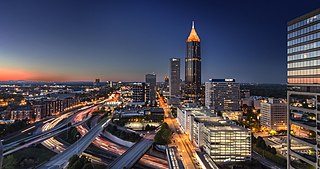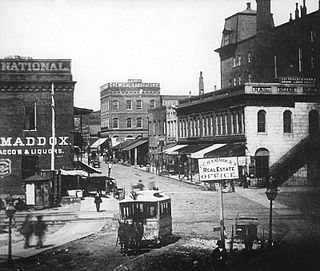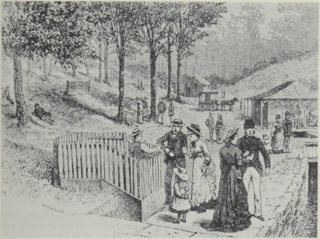
Fulton County is a county in the north-central portion of the U.S. state of Georgia. As of the 2020 United States census, the population was 1,066,710, making it the state's most populous county. Its county seat and most populous city is Atlanta, the state capital. About 90% of the city of Atlanta is within Fulton County; the remaining portion is in DeKalb County. Fulton County is the principal county of the Atlanta–Sandy Springs–Roswell metropolitan statistical area.

College Park is a city in Fulton and Clayton counties, Georgia, United States, adjacent to the southern boundary of the city of Atlanta. As of the 2020 census, the population was 13,930.

Sandy Springs is a city in northern Fulton County, Georgia, United States, and a suburb of Atlanta. The city's population was 108,080 at the 2020 census, making it Georgia's 7th most populous city. It is the site of several corporate headquarters, including UPS, Newell Brands, Inspire Brands, Focus Brands, Cox Enterprises, and Mercedes-Benz USA's corporate offices.

The history of Atlanta dates back to 1836, when Georgia decided to build a railroad to the U.S. Midwest and a location was chosen to be the line's terminus. The stake marking the founding of "Terminus" was driven into the ground in 1837. In 1839, homes and a store were built there and the settlement grew. Between 1845 and 1854, rail lines arrived from four different directions, and the rapidly growing town quickly became the rail hub for the entire Southern United States. During the American Civil War, Atlanta, as a distribution hub, became the target of a major Union campaign, and in 1864, Union William Sherman's troops set on fire and destroyed the city's assets and buildings, save churches and hospitals. After the war, the population grew rapidly, as did manufacturing, while the city retained its role as a rail hub. Coca-Cola was launched here in 1886 and grew into an Atlanta-based world empire. Electric streetcars arrived in 1889, and the city added new "streetcar suburbs".

Buckhead is the uptown commercial and residential district of the city of Atlanta, Georgia, comprising approximately the northernmost fifth of the city. Buckhead is the third largest business district within the Atlanta city limits, behind Downtown and Midtown, and a major commercial and financial center of the Southern U.S.

Buckhead Village is a neighborhood of Atlanta, Georgia, one of 42 neighborhoods in the larger Buckhead district and the community's historic business section. The Village as defined by the city as the area between Piedmont Road, Peachtree Road, and Pharr Road.
WABE – branded 90.1 FM WABE – is a non-commercial educational FM radio station licensed to Atlanta, Georgia, and serving the Atlanta metropolitan area, serving as the National Public Radio (NPR) member station for the market. Owned by Atlanta Public Schools and licensed to the Atlanta Board of Education, it is a sister outlet to PBS member station WABE-TV and local educational access cable service APS Cable Channel 22. The three outlets share studios on Bismark Road in the Morningside/Lenox Park section of Atlanta; WABE-TV's transmitter is located on New Street Northeast in the city's Edgewood neighborhood.
There were several historic mills around the metro Atlanta area, for which many of its current-day roads are still named. Most of the mills date back to the 1820s and 1830s, and were built along the area's many streams. The locations of many of these mills are shown on a map of 1875 showing U. S. military operations around Atlanta in 1864. This map is now located in the U. S. Library of Congress but can be seen on the webpage linked here.
Historic ferries operated on rivers around Atlanta, Georgia area, and became namesakes for numerous current-day roads in north Georgia. Most of the ferries date to the early years of European-American settlement in the 1820s and 1830s, when parts of the region were still occupied by cherokee and other Native American communities.

Cascade Heights is an affluent neighborhood in southwest Atlanta. It is bisected by Cascade Road, which was known as Sandtown Road in the nineteenth century. The road follows the path of the ancient Sandtown Trail which ran from Stone Mountain to the Creek village of Sandtown on the Chattahoochee River and from there on into Alabama. Ironically, the name lived on even after the Indians were expelled in the 1830s.

Westview Cemetery, located in Atlanta, Georgia, is the largest civilian cemetery in the Southeastern United States, comprising more than 582 acres (2.36 km2), 50 percent of which is undeveloped. The cemetery includes the graves of more than 125,000 people and was added to the Georgia Register of Historic Places in 2019 and the National Register of Historic Places in 2020.

Garden Hills is a neighborhood in the Buckhead section of Atlanta, Georgia between Peachtree and Piedmont Roads, bordered on the north by Pharr Road and on the south by Lindbergh Road. In 1987 the neighborhood was given historic district status by the city of Atlanta.

Chastain Memorial Park is the second largest city park in Atlanta, Georgia. It is a 268-acre (1.08 km2) park near the northern edge of the city. Included in the park are jogging paths, playgrounds, NYO ball fields, tennis courts, a golf course, swimming pool, horse park and amphitheater.

Capitol View is a historic intown southwest Atlanta, Georgia neighborhood. The neighborhood is 2.5 miles from downtown and was named for its views of the Georgia State Capitol building. Its boundaries include Metropolitan Parkway to the east, Lee Street to the west, and the Beltline to the north. On the south, the border follows Arden Street, Deckner Avenue, and Perkerson Park.

Metro Atlanta, designated by the United States Office of Management and Budget as the Atlanta–Sandy Springs–Roswell metropolitan statistical area, is the most populous metropolitan statistical area in the U.S. state of Georgia and the sixth-largest in the United States, based on the July 1, 2023 metropolitan area population estimates from the U.S. Census Bureau. Its economic, cultural, and demographic center is Atlanta, and its total population was 6,307,261 in the 2023 estimate from the U.S. Census Bureau.
The Autrey Mill Nature Preserve & Heritage Center is located in Johns Creek, Georgia, United States.

Buckhead Village District is a 9-acre (3.6 ha) planned mixed-use development in the Buckhead district in Atlanta, Georgia. The project is a redevelopment of part of the Buckhead Village neighborhood bounded by Peachtree Rd., E. Paces Ferry Rd., Pharr Rd., and N. Fulton Drive. It is located just 1.3 miles (2.1 km) from two of the region's most prominent and upscale malls, Lenox Square and Phipps Plaza.

Streetcars originally operated in Atlanta downtown and into the surrounding areas from 1871 until the final line's closure in 1949.

Ponce de Leon Springs was a mineral spring in Atlanta, Georgia, in the United States. The spring was a popular tourist destination from the mid-1800s through the early 1900s. Around the turn of the century, the land surrounding the spring was developed into an amusement park. By the 1920s, the amusement park was demolished, and the area was developed for industrial and, later, commercial properties.
North Fulton High School was a high school in northern Atlanta, Georgia. It was a part of Fulton County Public Schools and then Atlanta Public Schools. It merged into North Atlanta High School in 1991. The building now houses Atlanta International School.















